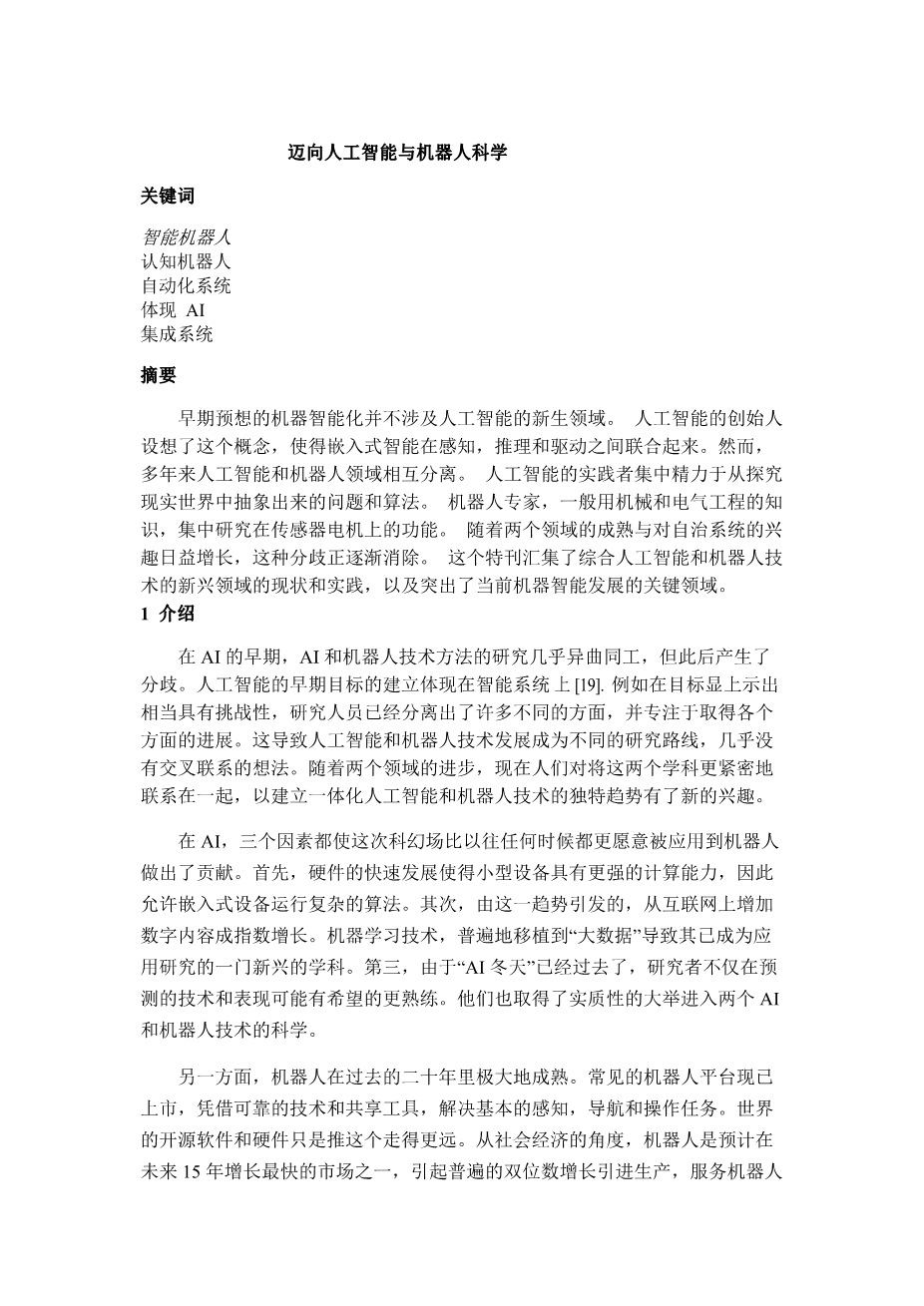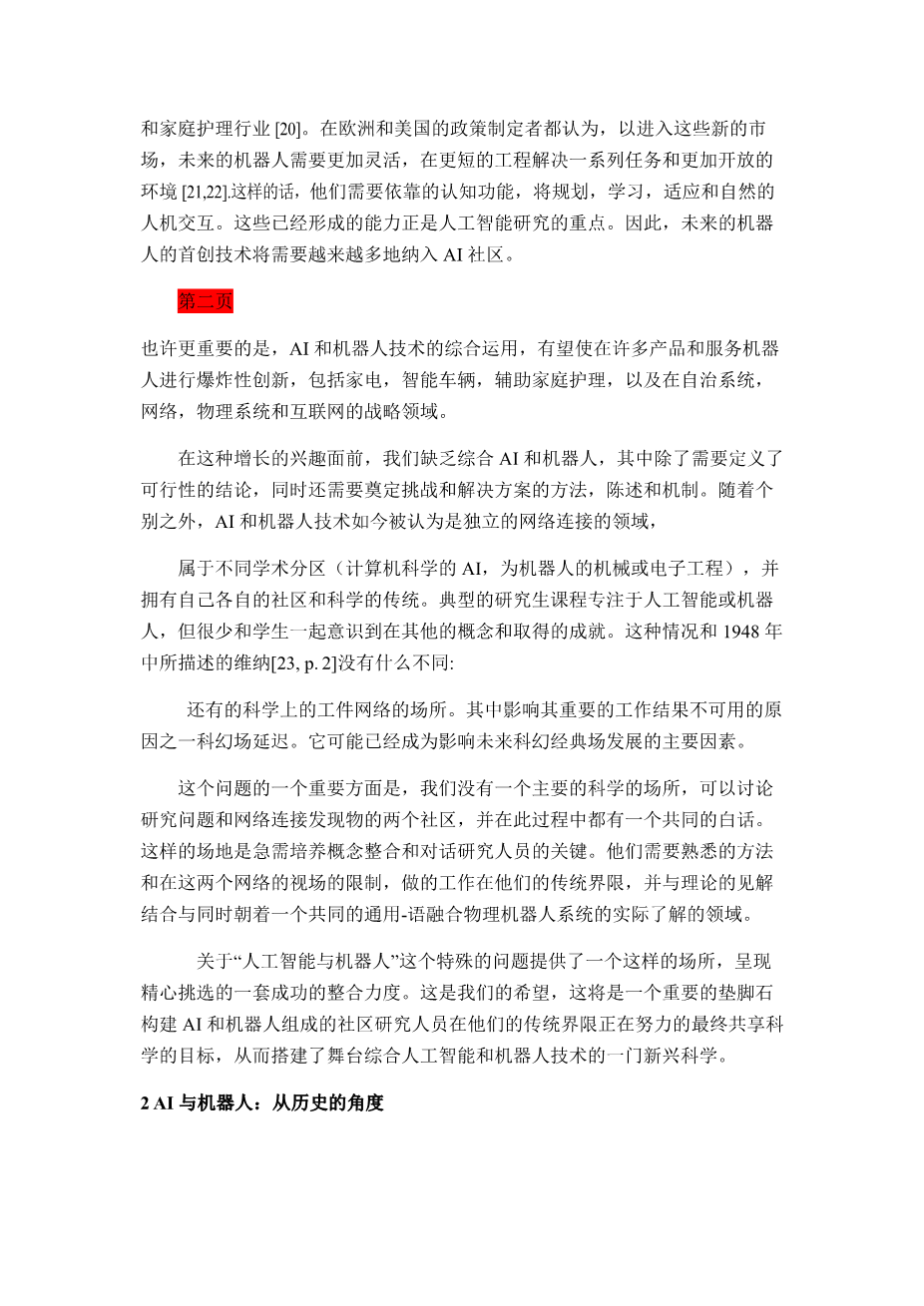Artificial Intelligence 247 (2017) 1–9
Contents lists available at ScienceDirect
Artificial Intelligence
www.elsevier.com/locate/artint
Editorial
Towards a science of integrated AI and Robotics
a r t i c l e i n f o a b s t r a c t
Keywords:
Intelligent robots
Cognitive robotics
Autonomous systems
Embodied AI
Integrated systems
The early promise of the impact of machine intelligence did not involve the partitioning
of the nascent field of Artificial Intelligence. The founders of AI envisioned the notion of
embedded intelligence as being conjoined between perception, reasoning and actuation.
Yet over the years the fields of AI and Robotics drifted apart. Practitioners of AI focused
on problems and algorithms abstracted from the real world. Roboticists, generally with
a background in mechanical and electrical engineering, concentrated on sensori-motor
functions. That divergence is slowly being bridged with the maturity of both fields and
with the growing interest in autonomous systems. This special issue brings together the
state of the art and practice of the emergent field of integrated AI and Robotics, and
highlights the key areas along which this current evolution of machine intelligence is
heading.
2017 Elsevier B.V. All rights reserved.
1. Introduction
The fields of Artificial Intelligence (AI) and Robotics were strongly connected in the early days of AI, but have since
diverged. One of the early goals of AI consisted of building embodied intelligent systems [19]. Such a goal however has
shown to be quite challenging, and researchers have isolated its many distinct facets and focused on making progress on
each facet separately; this has resulted in AI and Robotics developing as divergent research lines, with little in the way of
cross-pollination of ideas. With advancements in both fields, there is now a renewed interest in bringing the two disciplines
closer together, towards the establishment of a distinct trend in integrated AI and Robotics.
In AI, three factors have contributed to making this field more ready than ever to be applied to robotics. First, the rapid
progress in hardware has led to more computational power in smaller form-factor devices, thus allowing embedded devices
to run sophisticated algorithms. Second, and partly enabled by the first trend, is the exponential increase in data because
of increasing growth of digital content from the Internet. Machine learning techniques, popularly grafted onto “big data” as
a result, have become a burgeoning field of applied research. Third, having gone through an ‘AI Winter’, researchers have
not only become more adept at divining what techniques and representations are likely to be promising, they have also
made substantial inroads into the science of both AI and Robotics — contributions to this special issue clearly showcase
this.
Robotics on its side has matured enormously in the last two decades. Common robotic platforms are now available,
together with reliable techniques and shared tools to solve basic perception, navigation, and manipulation tasks; the world
of open source software and hardware has only pushed this further along. From a socio-economic perspective, robotics is
predicted to be one of the fastest growing markets in the next 15 years, with a double-digit growth caused by the pervasive
introduction of robots in production, service and home-care sectors [20]. Policy makers in Europe and the US agree that, to
enter these new markets, future robots will need to be more versatile and address a range of tasks in less engineered and
more open environments [21,22]. To do so, they will need to rely on cognitive capabilities such as knowledge representation,
planning, learning, adaptation, and natural human–robot interaction. These are precisely the capabilities that have formed
the focus of AI research for 60 years. Thus, future robots will need to increasingly incorporate techniques pioneered by
the AI community. Perhaps more importantly, the integrated use of AI and Robotics technologies is expected to enable
ttp://dx.doi.org/10.1016/j.artint.2017.03.003
0004-3702/ 2017 Elsevier B.V. All rights reserved.
2 Editorial
disruptive innovation in many products and services beyond robotics, including domestic appliances, intelligent vehicles,
assistive home care, as well as in the strategic areas of Autonomous Systems, Cyber-Physical Systems and the Internet of
Things.
In the face of this growing interest, we lack a clearly defined field of integrated AI and Robotics, which articulates
methods, representations and mechanisms that lead to enablement, while laying out challenges and solutions. With few
exceptions, AI and Robotics are today regarded as separate fields, that belong to different academic partitions (computer
science for AI, mechanical or electronic engineering for robotics), and have their own respective communities and scientific
traditions. Typical graduate student curricula concentrate on AI or on Robotics, but rarely on both, and students in one area
are seldom aware of the concepts and achievements in the other. This situation is not unlike the one described in 1948 by
Norbert Wiener [23, p. 2]:
There are fields of s
剩余内容已隐藏,支付完成后下载完整资料


英语译文共 17 页,剩余内容已隐藏,支付完成后下载完整资料
资料编号:[444087],资料为PDF文档或Word文档,PDF文档可免费转换为Word
以上是毕业论文外文翻译,课题毕业论文、任务书、文献综述、开题报告、程序设计、图纸设计等资料可联系客服协助查找。


